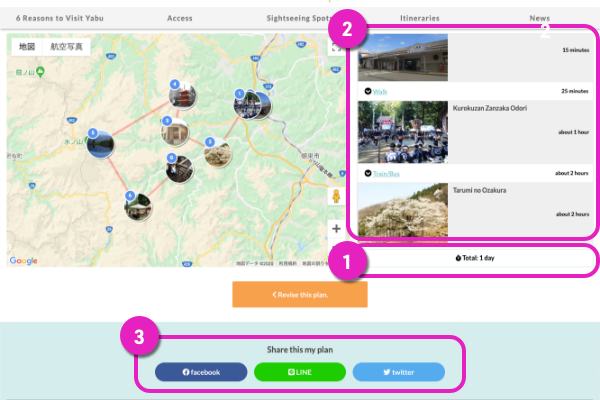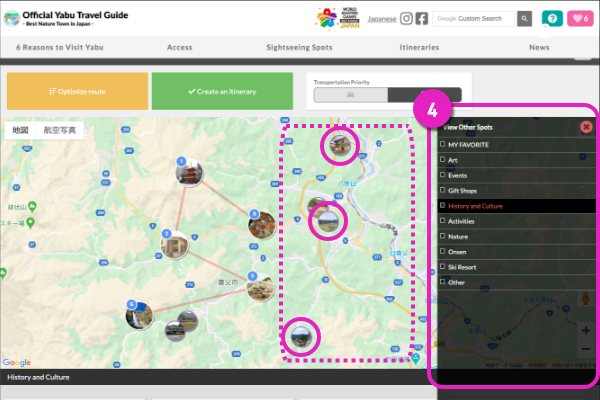How to make your own plan
Step 1
Search for places you want to visit


- Add the spots that you are interested in into ”My Plan” (your favorites)
- This can generate a route automatically by looking at the contents of ”My Plan”.
Step 2
Make a Day Plan!


- Using [My Favorite Spots] , you can put places you want to go into your plans.
- Sort in the most convenient order automatically
- Check the travel route and time by pressing the ”Direction” button (travel route by train, car or on foot will be shown).
- Create route with the ”Create an itinerary” button.
Step 3
Transfer the Plan to your smartphone and head out!

- Show the duration of the route.
- Display the entire route (by foot or by car).
- You can transfer the trip you created to your smartphone or to friends by sharing it on social media or entering your email address and sending it.
As this plan is information that was output to be shared, it will not be deleted even if the original plan is deleted.


- The plans you create will be saved under [My Plans]. Press [Create New Plan] to create a new plan.
- The plan name can be changed using the [Edit] button.
- If you press the [Pin] button, you are able to open the Category menu.
- Add the spots that you are interested in into “My Plan”


Chiba Prefecture Shrine Monument

A monument built by local farmers at the Ōaota Enfukuji Temple after a trial involving land owership of cultivated land.
| Address | 柏市大青田1101 |
|---|---|
| Tel | 04-7191-7414 |
| Fee | free |
The Main Gate of the Kashiwa Airfield

Established in Shōwa 13 (1938) as a base for Imperial Capital Defense. It is well known as the base of the rocket fighter "Shūsui" which was secretly developed by the military as a weapon to bomb the B29.
| Address | 柏市十余二 |
|---|---|
| Tel | 04-7191-7414 |
| Fee | free |
Kashiwa Airfield Shōsui Bunker

A bunker that stores fuel for Shōsui (a rocket fighter developed during the Second World War which was not used in combat). When the fuel “Kō” and “Otsu” come in contact, a large explosion occurs. Especially since "Kō" had a high chance of exploding, there was a need to place a bunker outside the base. Currently, a part of it is preserved in the Ichigō Kinrin Park.
| Address | 柏市十余二399-1 |
|---|---|
| Tel | 04-7132-8800 |
| Opening Hours | Summer (May to October) 10:00 -17:00, Winter (November to April) 10:00 -16:00 |
| Holiday | Mondays |
| Fee | free |
Kashiwa Airfield Entaigō

A facility (embankment) to protect and hide military aircraft from enemy air strikes and raids. It has been said that there were a total of 79 open-air bunkers at Kashiwa Air Base without rooves. Currently, it is preserved in the Konbukuro Pond Natural Museum Park.
| Address | 柏市十余二399-1 |
|---|---|
| Tel | 04-7132-8800 |
| Opening Hours | Summer (May to October) 10:00 -17:00, Winter (November to April) 10:00 -16:00 |
| Holiday | Mondays |
| Fee | free |
Former Army 4th Aviation Education Corps Management Gate

A year and a half after the opening of Kashiwa Airfield, it was relocated from Tachikawa, Tokyo. It is an educational unit which trains airmen on the ground mainly on duties such as aircraft maintenance. The gate was relocated to Bairin Daishi Park in Takata, Kashiwa City.
| Address | 柏市高田 |
|---|---|
| Tel | 04-7191-7414 |
| Fee | free |
Yagi Jyūkichi Poetry Monument

A poetry monument built at Higashi-Katsushika Junior High School (now Higashi-Katsushika High School), where Yagi Jyūkichi was an English teacher from Taishō 14 (1923) to Shōwa 2 (1942). His representative work, "Harappa", is about the vast fields of Koganehara, which was a former Koganemaki site and is well-known and popular as a simple, easy-to-understand poem.
| Address | 柏市旭町3丁目2-1 |
|---|---|
| Tel | 04-7191-7414 |
| Fee | free |
Designated National Historic Site Moto Sakura Castle Site

Built during the Bunmei Era (1469-1486) by the busho (Japanese military commander in the Sengoku period), Chiba Suketane. It flourished as the center of Shimōsa for more than 100 years until it was destoryed by Toyotomi Hideyoshi. Dry moats and mounds still remain in the vast castle, so you can enjoy the history of the area as you take a walk.
| Address | 酒々井町本佐倉 |
|---|---|
| Tel | 043-496-5334 |
| Fee | free |
Shimada Chōuemon Residence and Shimada Seigorō Residence

The Shimada Chōuemon Residence was the home of the family who worked on the Shogunate Wild Horse Business during the Edo period. The adjacent Shimada Seigorō family is a branch family of the Shimada Chōuemon family. The current building was built around Meiji 10 - 20 (1900-1920), making it a historical landscape. Only the exterior can be observed.
| Address | 酒々井町酒々井1688 |
|---|---|
| Tel | 043-496-5334 |
| Fee | free |
Mt. Tsuki

A small hill on the south side of Keisei-Shisui Station. This area is the residence of a wealthy kyūka (family of ancient extraction) and is also known to have been visited by Emperor Meiji as a part of his Imperial visit.
| Address | 酒々井町酒々井 |
|---|---|
| Tel | 043-496-5334 |
| Fee | free |
The Monument of Shisui

It is said that the name "Shisui" was derived from the story that the water drawn from a well found by a dutiful son turned into sake. The Monument of Shisui which passes on the legend is located on the grounds of Enpukuin Temple.
| Address | 酒々井町酒々井136 |
|---|---|
| Tel | 043-496-5334 |
| Fee | free |
Kamiiwahashi no Shishimai

A lion dance that has been held on the first Sunday of April every year since the Mid-Edo period to pray for bumper crops. Large and small lions perform "Tooshi", "Reitoro", "Shiraha", "Yumikuguri", and "Ippikimai" with musical accompaniment consisting of the flute and drum. They are performed in the order of Komagata Shrine, Kikuga Shrine, and Ōwashi Shrine.
| Address | 酒々井町上岩橋 |
|---|---|
| Tel | 043-496-5334 |
Mabashi no Shishimai

A lion dance that has been passed down since the Edo period, performed at the Katori Shrine on the third Saturday of July every year in prayer for bumper crops, peace and prosperity of the household, to drive away plagues and more. Performances such as “Shibashishi”, “Heisoku”, “Sarushishi”, and “Ken no Mai” are performed with musical accompaniment consisting of the flute and drum.
| Address | 酒々井町馬橋 |
|---|---|
| Tel | 043-496-5334 |
